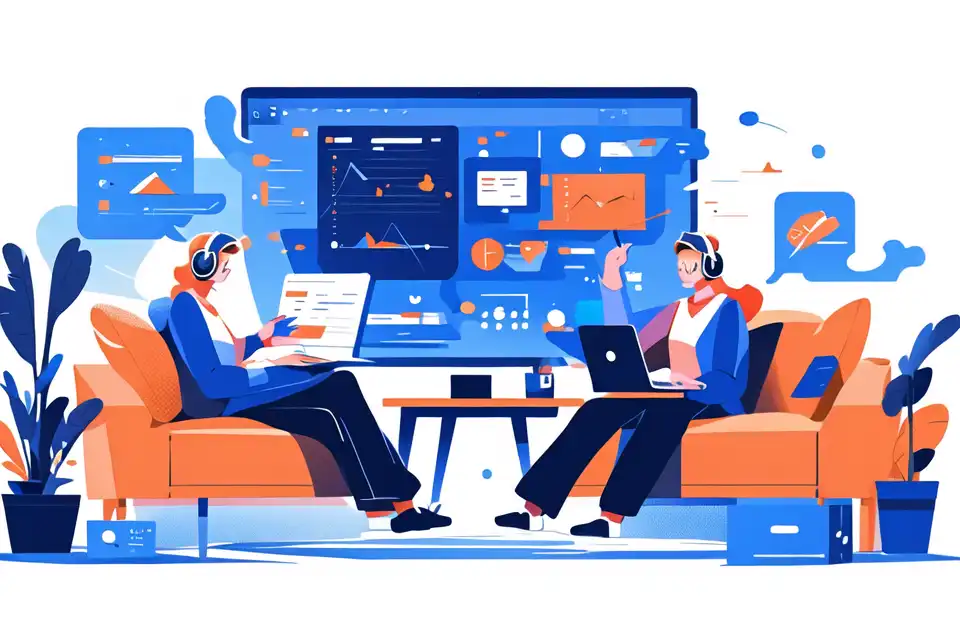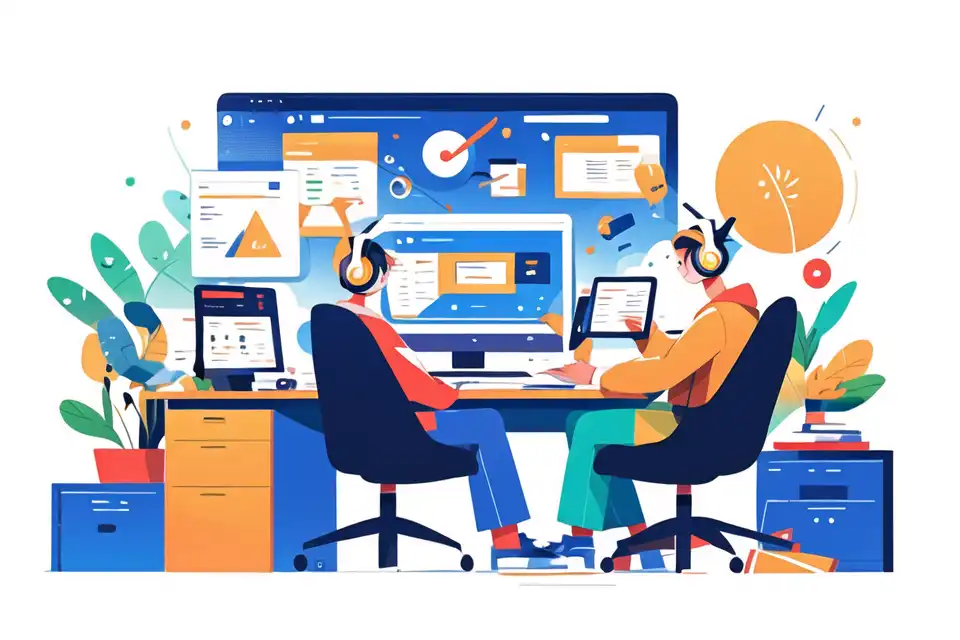Motion Design
Unlock the potential of Motion design with the comprehensive Lark glossary guide. Explore essential terms and concepts to excel in the gaming realm with Lark solutions.
Try Lark for Free
Motion design is a creative discipline that combines graphic design and animation to bring visual elements to life. In the gaming industry, motion design plays a crucial role in enhancing the overall gaming experience and immersing players in virtual worlds. This article will explore the definition of motion design and its relevance in the gaming industry, highlighting its importance for both gamers and gaming businesses.
Leverage the full capabilities of Lark Base to streamline, oversee, and successfully execute your real estate strategies and initiatives.
Define motion design and its relevance in the gaming industry
Motion design refers to the art of creating animated visuals and graphics that communicate messages and evoke emotions. In the gaming industry, motion design is used to animate characters, environments, and user interfaces, making the gaming experience more engaging and captivating. It adds a dynamic element to the static visuals, creating a sense of movement and realism.
Understanding motion design is essential for gamers as it enhances the gameplay experience by making it visually appealing and immersive. It brings game worlds to life, making them more vibrant and interactive. For gaming businesses, motion design is crucial for creating marketing materials, trailers, and promotional videos that attract and engage potential players. It helps in building a strong brand identity and establishing a connection with the target audience.
Significance of motion design in gaming
Motion design plays a significant role in the gaming industry for several reasons. Firstly, it enhances the visual aesthetic of games, making them more visually appealing and captivating for players. The fluid animations and dynamic graphics create a sense of realism and immersion, drawing players into the virtual worlds.
Secondly, motion design improves the user interface and user experience of games. Through intuitive animations and transitions, it guides players through different game menus, tutorials, and levels, making the gameplay more accessible and enjoyable. Clear and visually pleasing animations help players understand the game mechanics and navigate through complex environments.
Furthermore, motion design is crucial for storytelling in games. It allows developers to convey narratives and emotions through animated cutscenes and character movements. By using motion design techniques, game developers can create memorable and impactful storytelling moments that resonate with players on an emotional level.
Who benefits from motion design in the gaming industry
Motion design benefits various stakeholders in the gaming ecosystem. Gamers are the primary beneficiaries as they enjoy a more visually engaging and immersive gaming experience. The dynamic animations and graphics make the gameplay more exciting and captivating, enhancing their overall enjoyment.
Gaming businesses also benefit from motion design. By incorporating motion design into their marketing materials, game trailers, and promotional videos, they can attract a larger audience and generate more interest in their games. Effective use of motion design helps in creating a strong brand identity and establishing a unique visual style that sets a game apart from competitors.
Additionally, motion design benefits game developers and designers by providing them with a powerful tool to express their creativity and bring their ideas to life. It allows them to experiment with different animation techniques and visual styles, pushing the boundaries of game design and creating innovative experiences.
Related:
Overcast Games Software Development Service Chooses Lark to Power Effective Team CollaborationLearn more about Lark x Gaming Industry
How motion design works for gaming businesses
Motion design has practical implications for gaming businesses, impacting various aspects of their operations.
Practical Implications and Why It Matters
One practical implication of motion design for gaming businesses is its role in creating compelling marketing materials. By using animated graphics, game trailers, and promotional videos, businesses can effectively showcase the unique features and gameplay mechanics of their games. This helps in generating interest and attracting potential players.
Another practical implication is the improvement of user interface and user experience design. Motion design techniques can be used to create intuitive and visually pleasing interfaces that enhance the usability of games. Smooth animations and transitions make it easier for players to navigate through menus, understand game mechanics, and enjoy a seamless gaming experience.
Furthermore, motion design can be leveraged to create in-game animations and visual effects that enhance the gameplay. From character movements to environmental animations, motion design adds a layer of realism and interactivity to games, making them more engaging and immersive.
Best practices when considering motion design in gaming and why it matters
Implementing motion design effectively in the gaming industry requires following best practices and strategies. These practices ensure that the animations and graphics enhance the gaming experience and contribute to the overall success of the game.
One of the best practices is to maintain consistency in the visual style and animation techniques throughout the game. Consistency helps in creating a coherent and immersive experience for the players. It is important to establish a visual identity and stick to it throughout the game's development.
Another best practice is to focus on usability and user experience. The motion design should not only be visually appealing but also functional and intuitive. Animations should guide players and provide feedback, making it easier for them to understand the game mechanics and navigate through different levels.
Additionally, it is crucial to consider the technical limitations of the gaming platforms and devices. Different platforms may have varying capabilities and constraints when it comes to rendering animations. Optimization of motion design assets is necessary to ensure smooth performance on all supported platforms.
Related:
Overcast Games Software Development Service Chooses Lark to Power Effective Team CollaborationLearn more about Lark x Gaming Industry
Actionable tips for leveraging motion design in the gaming industry
To leverage motion design effectively in the gaming industry, consider the following actionable tips:
[Insert best tip 1 here]
- Utilize motion design to create visually stunning game trailers that capture the essence of the gameplay and attract potential players.
- Use captivating animations and transitions in the user interface to make it intuitive and visually pleasing.
- Ensure that the motion design aligns with the game's theme and narrative to create a cohesive and immersive experience.
[Insert best tip 2 here]
- Experiment with different animation techniques and visual styles to create a unique and memorable gaming experience.
- Pay attention to the timing and pacing of animations to ensure they complement the gameplay and enhance the player's emotional engagement.
- Collaborate with motion design professionals who specialize in the gaming industry to leverage their expertise and create high-quality animations.
[Insert best tip 3 here]
- Optimize motion design assets to ensure smooth performance on different gaming platforms and devices.
- Test the animations on various hardware configurations to identify and address any performance issues.
- Continuously gather feedback from players and make improvements based on their input to enhance the overall gaming experience.
Related terms and concepts to motion design in the gaming industry
Understanding motion design in the gaming industry involves knowledge of related terms and concepts. Some of these include:
Related Term or Concept 1
- Animation: The process of creating the illusion of motion by rapidly displaying a sequence of static images.
- User Interface (UI) Design: The design of the visual elements and interactive components that facilitate the interaction between the player and the game.
- Game Development: The process of creating a video game, including designing the gameplay mechanics, visuals, and audio.
Related Term or Concept 2
- Visual Effects (VFX): The creation of realistic or fantastical visual elements that enhance the overall aesthetic and immersion of a game.
- Character Animation: The process of bringing virtual characters to life by animating their movements and expressions.
- Graphic Design: The art of creating visual content for communication purposes, including logos, illustrations, and user interfaces.
Related Term or Concept 3
- Cinematics: Pre-rendered or real-time animated sequences used to tell a story or provide important narrative moments in a game.
- Interactive Design: The design of interactive elements and experiences that engage the player and enhance their immersion in the game.
- 3D Modeling: The creation of three-dimensional virtual objects and environments using specialized software.
Learn more about Lark x Gaming Industry
Conclusion
Motion design plays a crucial role in the gaming industry, enhancing the visual aesthetic, user experience, and storytelling in games. It is vital for both gamers and gaming businesses, creating more immersive and engaging experiences while also attracting a larger audience. By following best practices and leveraging motion design effectively, gaming businesses can create visually stunning games that captivate players and leave a lasting impression.
Continuous learning and adaptation are essential in the dynamic gaming landscape, as technology and player expectations continue to evolve. Staying up-to-date with the latest motion design techniques and trends is crucial for game developers and designers to create innovative and compelling gaming experiences.
Faq
Question 1
What is motion design in gaming?
Answer Motion design in gaming refers to the creation of animated visuals and graphics that enhance the gaming experience. It involves animating characters, environments, and user interfaces to make the gameplay more visually appealing and immersive.
Question 2
Why is motion design important in the gaming industry?
Answer Motion design is important in the gaming industry because it enhances the visual aesthetic of games, improves the user interface and user experience, and contributes to the storytelling aspect of games. It creates a more immersive and engaging gaming experience for players.
Question 3
Who benefits from motion design in the gaming industry?
Answer Various stakeholders benefit from motion design in the gaming industry. Gamers enjoy a more visually engaging and immersive gaming experience, while gaming businesses can attract a larger audience and generate more interest in their games. Game developers and designers benefit from motion design by having a powerful tool to express their creativity and bring their ideas to life.
Question 4
What are the best practices for implementing motion design in gaming?
Answer Some best practices for implementing motion design in gaming include maintaining consistency in visual style and animation techniques, focusing on usability and user experience, and considering the technical limitations of gaming platforms and devices. Collaboration with motion design professionals and continuous gathering of player feedback are also important.
Question 5
What are some actionable tips for leveraging motion design in the gaming industry?
Answer Some actionable tips for leveraging motion design in the gaming industry include creating visually stunning game trailers, using captivating animations in the user interface, experimenting with different animation techniques and visual styles, optimizing motion design assets for smooth performance, and continuously gathering feedback from players for improvements.
Question 6
What are some related terms and concepts to motion design in the gaming industry?
Answer Related terms and concepts to motion design in the gaming industry include animation, user interface design, game development, visual effects, character animation, graphic design, cinematics, interactive design, and 3D modeling. Understanding these terms and concepts is important for a comprehensive understanding of motion design in gaming.
Leverage the full capabilities of Lark Base to streamline, oversee, and successfully execute your real estate strategies and initiatives.








